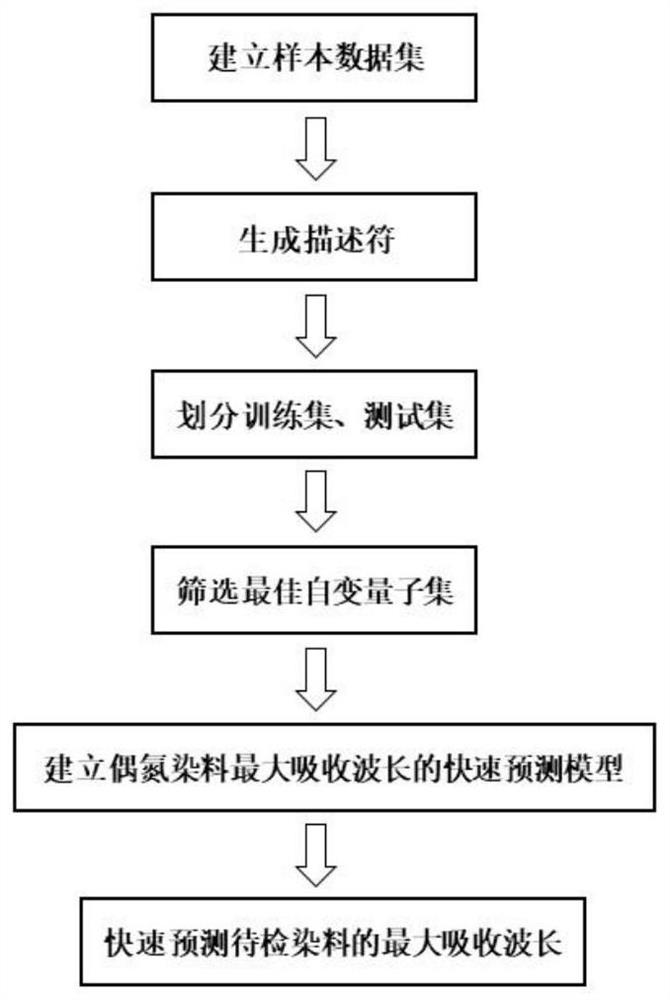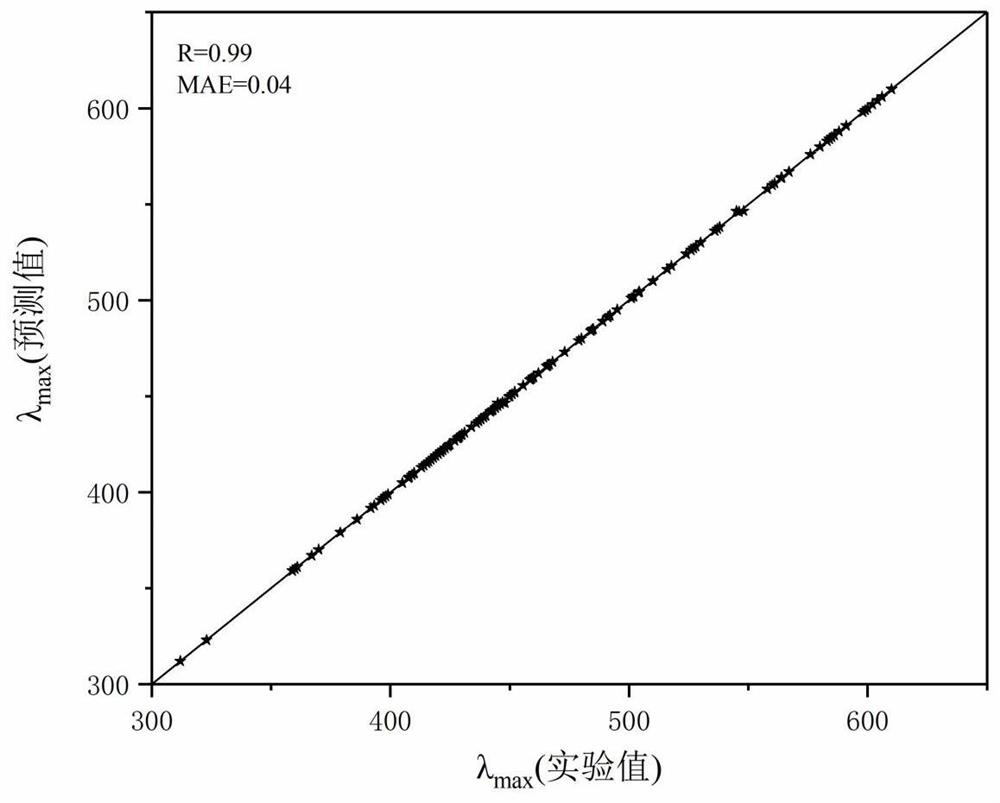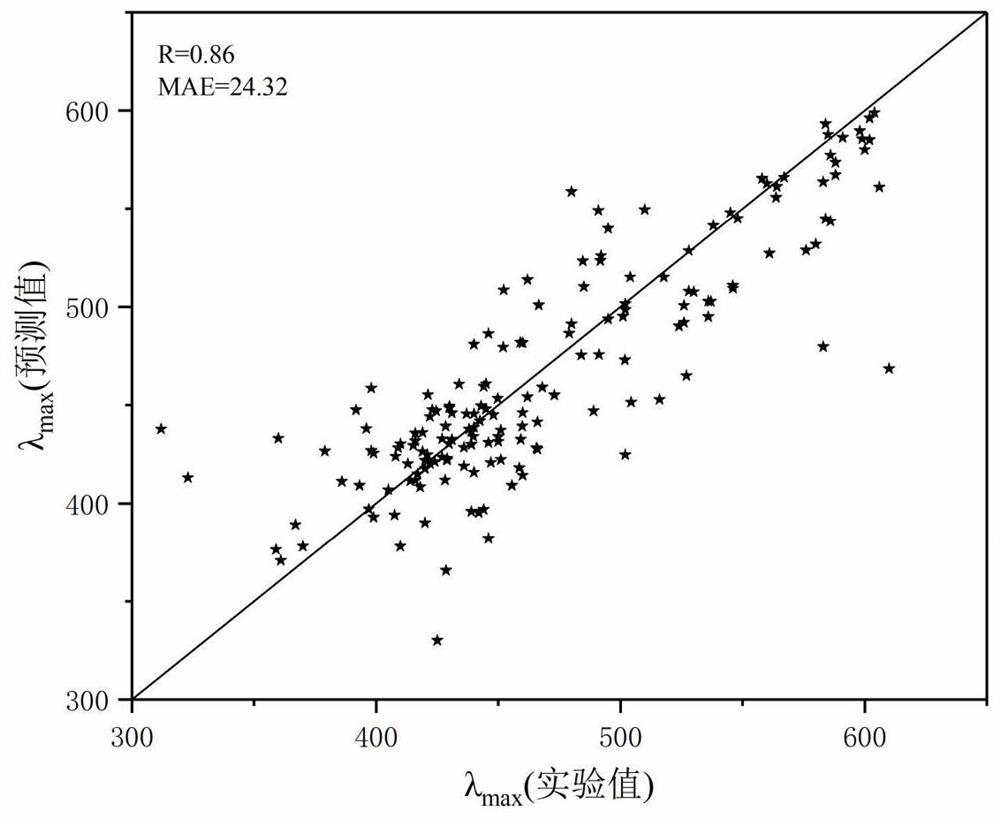Method and system for quickly predicting maximum absorption wavelength of dye
A technology of maximum absorption wavelength and dye, applied in the field of dye absorption spectrum research, can solve the problems of high detection cost and time-consuming, and achieve the effect of simple operation process, convenient use and high timeliness
- Summary
- Abstract
- Description
- Claims
- Application Information
AI Technical Summary
Problems solved by technology
Method used
Image
Examples
Embodiment 1
[0064] In this embodiment, see figure 1 and figure 2 A method of the maximum absorption wavelength of the dye based on the predicted fast XGBoost algorithm, comprising the steps of:
[0065] After 1) using a computer system, to find an azo dye and a molecular structure corresponding to the maximum absorption wavelength from the experimental literature, data preprocessing, sorting molecular structure of the sample, obtaining a sample of the maximum absorption wavelength Found, pretreatment sample data set as a sample data set subsequent modeling;
[0066] 2) the sample using chemical drawing program of the data set, painting the dye molecular structure obtained collected by descriptor generation program generates respective descriptor;
[0067] 3) the maximum absorption wavelength of the sample data set of experiments is the objective variable, using the generated descriptor as an argument, by the screening method of removing redundant variable arguments, retaining the best subset ...
Embodiment 2
[0074] The present embodiment is substantially the same as first embodiment, is unique in that:
[0075] In the present embodiment, in a) in the step 2, using Chemdraw software, plotted to give the molecular structure of the dye collected, and its molecular structure derived SMILES string, and then generates a corresponding software Dragon descriptor.
[0076] In the present embodiment, in a) in said step 3, the maximum absorption wavelength of the target value of the experimental variables, using Dragon software generated descriptor as an argument, deleting the inter-variable correlation coefficient of 0.99 in the variable a variable, which retained the larger of the self correlation coefficient with the target variable, obtained from the initial screening of variable data, and target variable data sets. The present embodiment calculates the correlation coefficient between the target value and between various features, sorted according to the size of the correlation coefficient, ...
Embodiment 3
[0081] This embodiment is substantially the same as the above embodiment, and in particular
[0082] In the present embodiment, in the step 5), the new self-variable obtained is:
[0083] P (1) = - 0.1468X 1 + 0.07953X 2 + 0.005442X 3 -0.1144x 4 -0.03946X 5 -0.7645x 6 -0.1187x7-0.02542x8 + 0.2509x9 + 0.2106x10 + 1.518x11-1.490x12 + 0.3446x13 + 1.073x14 + 0.1408x15 + 0.008882x16 + 3.373x17-0.08313x18 + 0.08137x19-0.1829x20 + 0.1180x21-0.1042x22-2.007 ;
[0084] P (2) = - 0.3452X 1 -0.001333X 2 -0.1305x 3 + 0.03473X 4 + 0.06318X 5 + 0.5968X 6 -0.08493x 7 -0.05796X 8 -0.4417x 9 -0.0002596X 10 + 0.8958X 11 + 0.6900X 12 -0.1266x 13 + 0.3495X 14 -0.002020X 15 -0.03937X 16 + 4.958X 17 -0.2235x 18 + 0.06097X 19 -0.8796x 20 -0.04725x 21 + 0.007784X 22 -3.015;
[0085] P (3) = - 0.04478X 1 + 0.03094X 2 + 0.1164X 3 + 0.4955X 4 + 0.1280X 5 + 0.5930X 6 -0.2875x 7 + 0.1254X 8 + 0.4020X 9 + 0.08689X 10 -0.6100X 11 + 1.735X 12 -0.01940x 13 + 0.004682X 14 + 0.05438X 15 + 0.2704X 16 + 6.064X 17 -0....
PUM
 Login to View More
Login to View More Abstract
Description
Claims
Application Information
 Login to View More
Login to View More - R&D
- Intellectual Property
- Life Sciences
- Materials
- Tech Scout
- Unparalleled Data Quality
- Higher Quality Content
- 60% Fewer Hallucinations
Browse by: Latest US Patents, China's latest patents, Technical Efficacy Thesaurus, Application Domain, Technology Topic, Popular Technical Reports.
© 2025 PatSnap. All rights reserved.Legal|Privacy policy|Modern Slavery Act Transparency Statement|Sitemap|About US| Contact US: help@patsnap.com



